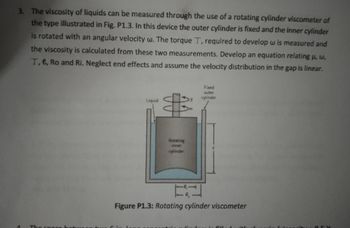
Elements Of Electromagnetics
7th Edition
ISBN: 9780190698614
Author: Sadiku, Matthew N. O.
Publisher: Oxford University Press
expand_more
expand_more
format_list_bulleted
Concept explainers
Question

Transcribed Image Text:3. The viscosity of liquids can be measured through the use of a rotating cylinder viscometer of
the type illustrated in Fig. P1.3. In this device the outer cylinder is fixed and the inner cylinder
is rotated with an angular velocity w. The torque T, required to develop w is measured and
the viscosity is calculated from these two measurements. Develop an equation relating μ, w,
T, e, Ro and Ri. Neglect end effects and assume the velocity distribution in the gap is linear.
The space
Liquid
$
Rotating
inner
cylinder
Fixed
outer
cylinder
Figure P1.3: Rotating cylinder viscometer
GIL
Expert Solution
This question has been solved!
Explore an expertly crafted, step-by-step solution for a thorough understanding of key concepts.
This is a popular solution
Trending nowThis is a popular solution!
Step by stepSolved in 3 steps with 3 images

Knowledge Booster
Learn more about
Need a deep-dive on the concept behind this application? Look no further. Learn more about this topic, mechanical-engineering and related others by exploring similar questions and additional content below.Similar questions
- Please show complete solution and clear explanation, thank you.arrow_forwardFor the flow of gas between two parallel plates of Fig. 1.7,reanalyze for the case of slip fl ow at both walls. Use thesimple slip condition, δu wall = l ( du/dy ) wall , where l isthe mean free path of the fl uid. Sketch the expected velocityprofile and find an expression for the shear stress ateach wall.arrow_forwardfluid mechanicsarrow_forward
- If 10 m^3 of atmospheric air at 1 degree centigrade temperature are compressed to a volume of 1m^3 at 100°C, what will be the pressure of air?arrow_forwardProblem 2 The apparatus sketched in the figure below serves as a viscometer i.e. it can be used to measure the viscosity of a liquid. In the drawing, D is a large reservoir containing a viscous liquid A and E is a cylindrical tube of radius R, open at both ends, surrounding and coaxial with B, which is a cylindrical "bob" of radius êR that is dragged up through the fluid by a frictionless pulley system (C) utilizing a weight W. Determine a design equation that relates the viscosity of the liquid to the geometry of the system and the weight W. Hint: you can assume that the length of the cylindrical tube is sufficiently long for the flow to reach steady state. W E D Barrow_forwardExample 3.8.In Example 3.7 we considered a vacuum system with zero leaks. No real vacuum systems aretotally leak-free; engineers work very hard to keep the leakage rate as low as possible. If thetank in Example 3.7 has a leak of 0.0001 lbm/min of air, what will the pressure-time plot looklike, and what will be the final pressure? ex: 3.7 is postedarrow_forward
- 1. A pressure gauge attached to a pipe is reading 1.34 m of Hg at a place where the atmospheric pressure is 10.33 m of water. The approximate absolute pressure at the mountain isa. 930 kPab. 181 kPac. 280 kPad. 100 kPa 2. The flow is said to be unsteady and non-uniform when,a. The flow velocity is not changing with time but changing with spaceb. The flow velocity is changing with both time and spacec. The flow velocity is changing with time but not changing with spaced. The flow velocity is not changing with both time and space 3. The below figure shows a pipe with a circular cross section of diameter D mm on the left end and a square cross section with side D mm on the right end. Mercury enters the left end with a velocity 1 cm/s and leaves the right end with a velocity V2. Find V2 (neglect losses in the pipe).a. Cannot be find since length is not givenb. Cannot be find since diameter is not givenc. 7.85 mm/sd. 12.73 mm/s 4. 1 kg water is flowing through an inclined pipe at…arrow_forwardFind visocisity of whole blood @ 37oCarrow_forwardSuppose your bicycle tire is fully inflated, with an absolute pressure of 7.00 X 105 Pa (a gauge pressure of just under 90.0 lb/in2) at a temperature of 18.0oC. What is the pressure after its temperature has risen to 35.0oC? Assume that there are no appreciable leaks or changes in volume.arrow_forward
arrow_back_ios
arrow_forward_ios
Recommended textbooks for you
 Elements Of ElectromagneticsMechanical EngineeringISBN:9780190698614Author:Sadiku, Matthew N. O.Publisher:Oxford University Press
Elements Of ElectromagneticsMechanical EngineeringISBN:9780190698614Author:Sadiku, Matthew N. O.Publisher:Oxford University Press Mechanics of Materials (10th Edition)Mechanical EngineeringISBN:9780134319650Author:Russell C. HibbelerPublisher:PEARSON
Mechanics of Materials (10th Edition)Mechanical EngineeringISBN:9780134319650Author:Russell C. HibbelerPublisher:PEARSON Thermodynamics: An Engineering ApproachMechanical EngineeringISBN:9781259822674Author:Yunus A. Cengel Dr., Michael A. BolesPublisher:McGraw-Hill Education
Thermodynamics: An Engineering ApproachMechanical EngineeringISBN:9781259822674Author:Yunus A. Cengel Dr., Michael A. BolesPublisher:McGraw-Hill Education Control Systems EngineeringMechanical EngineeringISBN:9781118170519Author:Norman S. NisePublisher:WILEY
Control Systems EngineeringMechanical EngineeringISBN:9781118170519Author:Norman S. NisePublisher:WILEY Mechanics of Materials (MindTap Course List)Mechanical EngineeringISBN:9781337093347Author:Barry J. Goodno, James M. GerePublisher:Cengage Learning
Mechanics of Materials (MindTap Course List)Mechanical EngineeringISBN:9781337093347Author:Barry J. Goodno, James M. GerePublisher:Cengage Learning Engineering Mechanics: StaticsMechanical EngineeringISBN:9781118807330Author:James L. Meriam, L. G. Kraige, J. N. BoltonPublisher:WILEY
Engineering Mechanics: StaticsMechanical EngineeringISBN:9781118807330Author:James L. Meriam, L. G. Kraige, J. N. BoltonPublisher:WILEY

Elements Of Electromagnetics
Mechanical Engineering
ISBN:9780190698614
Author:Sadiku, Matthew N. O.
Publisher:Oxford University Press

Mechanics of Materials (10th Edition)
Mechanical Engineering
ISBN:9780134319650
Author:Russell C. Hibbeler
Publisher:PEARSON

Thermodynamics: An Engineering Approach
Mechanical Engineering
ISBN:9781259822674
Author:Yunus A. Cengel Dr., Michael A. Boles
Publisher:McGraw-Hill Education

Control Systems Engineering
Mechanical Engineering
ISBN:9781118170519
Author:Norman S. Nise
Publisher:WILEY

Mechanics of Materials (MindTap Course List)
Mechanical Engineering
ISBN:9781337093347
Author:Barry J. Goodno, James M. Gere
Publisher:Cengage Learning

Engineering Mechanics: Statics
Mechanical Engineering
ISBN:9781118807330
Author:James L. Meriam, L. G. Kraige, J. N. Bolton
Publisher:WILEY